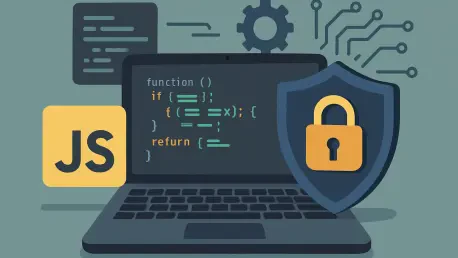JavaScript powers nearly every corner of the internet, from dynamic front-end interfaces to robust back-end solutions and intricate API integrations, making it a prime target for cybercriminals. Its widespread use across web development, coupled with billions of users interacting with JavaScript-driven applications daily, means that a single security flaw can lead to catastrophic data breaches or user harm. The stakes are high, as insecure coding practices can compromise not just individual projects but entire ecosystems of trust.
The importance of secure coding cannot be overstated in an era where cyber threats evolve rapidly. Developers must prioritize security to safeguard sensitive information, maintain user confidence, and protect organizational reputations. Platforms like Stack Overflow, where code snippets and solutions are shared widely, amplify the need for vigilance, as a vulnerable piece of code can be replicated across countless projects. This guide aims to equip developers with practical strategies to mitigate risks effectively.
This resource outlines ten actionable tips to enhance JavaScript security, tailored for developers engaging with communities like Stack Overflow. By adopting these practices, coders can prevent common attacks, fortify their applications, and contribute to a safer digital environment. The following sections delve into specific threats and offer clear, implementable advice to address them, ensuring robust protection for both developers and end-users.
The Persistent Threat of Cross-Site Scripting (XSS) in JavaScript
Cross-Site Scripting, commonly known as XSS, remains a critical concern for JavaScript developers despite advancements in security awareness. This type of injection attack targets users directly by manipulating the browser to execute malicious code, often disguised as legitimate data. Unlike other injection attacks such as SQL or command injections that target servers or systems, XSS exploits the client-side environment, posing unique challenges in detection and prevention.
The consequences of XSS can be severe, ranging from unauthorized access to cookies and session data to the installation of keyloggers or website defacement. Attackers leverage the capabilities of JavaScript itself, limited only by their creativity, to wreak havoc on unsuspecting users. Even a small oversight in code can open the door to such exploits, making it imperative for developers to understand the mechanics of these attacks and the importance of proactive defenses.
While the incidence of XSS attacks has decreased over recent years due to better education, community initiatives like OWASP, and built-in protections in modern frameworks, the threat has not been eradicated. Many developers still fall prey to complacency or lack of knowledge, especially when working on legacy systems or under tight deadlines. Continuous vigilance and adherence to best practices are essential to keep this persistent danger at bay.
10 Essential Tips for Writing Secure JavaScript Code
Tip 1: Validate All User Input Rigorously
Building a Strong First Line of Defense
User input represents a primary entry point for potential threats in any application. Validating all data supplied by users is a fundamental step to ensure that malicious content does not infiltrate the system. This process involves checking for expected formats, types, and values to filter out anything suspicious before it can cause harm.
To strengthen this defense, developers must escape or sanitize potentially hazardous characters such as angle brackets, quotes, or hyphens. Escaping adds a protective layer by neutralizing harmful elements, while sanitization might involve replacing or removing them altogether. Implementing these checks on the backend, rather than solely on the client side, is crucial since front-end validations can be bypassed using tools like intercept proxies.
Robust input validation not only prevents attacks like XSS but also enhances overall application reliability. Developers should adopt strict allowlists over denylists where possible, defining exactly what is acceptable rather than attempting to block known threats. This approach reduces the risk of overlooking emerging attack patterns and fortifies the application against manipulation.
Tip 2: Implement Output Encoding for Safe Rendering
Preventing Malicious Code Execution on Display
Output encoding is a vital technique to ensure that data rendered on the screen does not execute as code. This step is particularly important for content sourced from user inputs or external APIs, which might contain hidden malicious scripts. Encoding transforms potentially dangerous characters into safe representations that the browser interprets as plain text.
Leveraging frameworks that automate output encoding can simplify this process and reduce human error. However, caution is advised when dealing with manual encoding, especially in scenarios involving inline JavaScript, where nested encoding can become complex and error-prone. Developers must prioritize automated solutions wherever feasible to maintain consistency and effectiveness.
The significance of output encoding extends to protecting users from unintended code execution during data display. By diligently applying this practice across all rendered content, developers can significantly diminish the likelihood of XSS attacks. Regularly reviewing encoding mechanisms ensures they remain effective against evolving threat landscapes.
Tip 3: Utilize Content Security Policy (CSP) Headers
Blocking Unauthorized External Scripts
Content Security Policy headers serve as a powerful barrier against XSS by restricting the sources from which scripts and other resources can be loaded. By explicitly defining trusted domains, developers can prevent attackers from injecting malicious external scripts into the application. This measure drastically curtails the attack surface available to exploiters.
Implementing CSP involves specifying allowed origins for scripts, styles, and other assets within the HTTP headers of a web application. This proactive restriction ensures that even if an attacker manages to inject code, the browser will refuse to execute scripts from unapproved sources. Such a policy acts as a critical safeguard in environments prone to third-party dependencies.
Adopting CSP headers not only enhances security but also fosters a disciplined approach to resource management. Developers should regularly update and refine these policies to reflect changes in application architecture or trusted sources. This ongoing maintenance is essential to keep protection levels high amidst shifting digital threats.
Tip 4: Secure Cookies with HttpOnly Flags
Protecting Sensitive Session Data
Cookies often store sensitive session information, making them a prime target for XSS attacks. Setting the HttpOnly flag on cookies prevents client-side scripts from accessing this data, thereby adding a crucial layer of protection. This simple configuration can thwart attackers even if other security measures are breached.
The HttpOnly flag ensures that cookies are only accessible via HTTP requests and not through JavaScript, effectively blocking unauthorized access during an XSS exploit. This defense mechanism is particularly valuable for safeguarding user authentication tokens and other critical data stored in cookies. Its implementation should be a standard practice for all web applications.
Beyond immediate protection, securing cookies with HttpOnly flags underscores the importance of layered security strategies. Developers must combine this approach with other measures to create a comprehensive defense system. Regularly auditing cookie settings ensures that no sensitive data remains exposed due to oversight or misconfiguration.
Tip 5: Conduct Thorough Code Reviews and Security Testing
Catching Vulnerabilities Before They Strike
Regular code reviews and security testing are indispensable for identifying vulnerabilities that might be missed during development. Manual reviews by peers can uncover logical flaws or insecure practices, while automated tools like static analysis (SAST) and dynamic analysis (DAST) provide systematic checks for common issues. These combined efforts fortify application integrity.
Penetration testing takes security evaluation a step further by simulating real-world attacks to expose weaknesses. This proactive approach helps developers understand how an attacker might exploit their code and allows for timely remediation. Integrating such testing into the development lifecycle ensures that security remains a priority at every stage.
The benefits of thorough reviews and testing extend beyond immediate bug fixes to fostering a culture of accountability among development teams. Emphasizing these practices encourages continuous improvement and awareness of security concerns. Developers should document findings and solutions to build a knowledge base for future reference and learning.
Tip 6: Leverage Modern Frameworks with Built-In Protections
Avoiding Dangerous Functions in React, Angular, and Vue.js
Modern JavaScript frameworks such as React, Angular, and Vue.js come equipped with built-in security features like automatic output encoding. These mechanisms reduce the burden on developers to manually handle certain risks, offering a safer foundation for building applications. However, reliance on these features must be balanced with caution.
Certain framework functions, like React’s dangerouslySetInnerHTML or Angular’s bypassSecurityTrust methods, can introduce vulnerabilities if misused. Developers should consult framework documentation to understand the risks associated with such features and adhere to recommended safe usage practices. Awareness of these pitfalls is key to maintaining security.
Utilizing frameworks effectively requires a commitment to staying informed about updates and security advisories. While these tools provide significant protections, they are not foolproof, and developers must remain vigilant. Combining framework safeguards with manual security practices ensures a more resilient application architecture.
Tip 7: Separate JavaScript from HTML for Clarity and Safety
Reducing XSS Risk with External Files
Embedding JavaScript directly within HTML, often for quick fixes or prototyping, heightens the risk of XSS attacks and complicates maintenance. Keeping JavaScript in separate external files not only enhances code organization but also minimizes exposure to injection vulnerabilities. This separation is a fundamental best practice for secure coding.
External JavaScript files can be defined within CSP headers, ensuring that only approved scripts are executed. This structure reduces the likelihood of inline scripts being exploited by attackers and simplifies the process of updating or auditing code. A clean separation fosters both security and scalability in application development.
Adopting this practice contributes to long-term project health by making codebases easier to manage and review. Developers should establish clear guidelines for script organization early in the development process to prevent inline scripting habits from taking root. Consistent adherence to this principle significantly bolsters application defenses.
Tip 8: Enforce Strict Mode for Cleaner, Safer Code
Tightening Rules for Better Security
Strict mode in JavaScript enforces stricter parsing and error handling, helping developers write safer and more predictable code. By enabling this mode, silent errors are eliminated, unsafe actions are prohibited, and the risk of accidental global variables is reduced. It serves as a valuable tool for enhancing code quality.
Beyond error prevention, strict mode improves performance and aids in early bug detection by enforcing best practices. It also makes the use of the ‘this’ keyword more reliable, reducing ambiguity in code execution. These benefits collectively contribute to a more secure and maintainable coding environment.
Implementing strict mode should be a standard practice across all JavaScript projects to maximize its advantages. Developers can activate it by adding a simple declaration at the beginning of scripts or functions. This small step yields significant returns in terms of both security and overall code integrity.
Tip 9: Use Trusted Open-Source Tools for Security
Enhancing Protection with Community Solutions
The open-source community offers a wealth of free tools to bolster JavaScript security, such as DOMPurify for input sanitization and Retire.js for detecting outdated libraries. Other resources like Npm Audit, Yarn Audit, and ZAP for dynamic analysis provide additional layers of protection. These tools empower developers to address vulnerabilities efficiently.
While leveraging these solutions, caution must be exercised, particularly with tools like ZAP, which require explicit permission before use on any system to avoid legal or ethical issues. Understanding the scope and limitations of each tool ensures they are applied correctly without causing unintended consequences. Proper documentation and guidelines are essential for safe usage.
Incorporating trusted open-source tools into development workflows can significantly elevate security standards. Developers should regularly evaluate and update their toolsets to align with current threats and best practices. This proactive approach leverages community-driven innovation to safeguard applications effectively.
Tip 10: Handle User Data Safely in DOM and CSS
Ensuring Text Stays Text, Not Code
Treating user input as plain text rather than executable code is critical when interacting with the DOM or CSS. Using methods like innerText or textContent instead of innerHTML ensures that data is displayed without being interpreted as code. This distinction prevents unintended script execution by the browser.
When setting attributes with user data via element.setAttribute, only static, safe attributes should be used, avoiding dynamic ones like onclick that could trigger actions. Similarly, in CSS, user data must be confined to property values rather than contexts to prevent manipulation. These precautions maintain strict control over how data is processed.
Applying these rules consistently across all user interactions with DOM and CSS elements minimizes security risks. Developers should establish clear protocols for handling such data, ensuring that text remains text at every touchpoint. This disciplined approach is a cornerstone of preventing client-side exploits.
Quick Recap: Key Takeaways for Secure JavaScript Coding
- Validate all user input to block malicious data.
- Encode output to prevent code execution on display.
- Use CSP headers to limit third-party scripts.
- Secure cookies with HttpOnly flags.
- Review code and test rigorously for vulnerabilities.
- Rely on frameworks’ built-in security features cautiously.
- Keep JavaScript external from HTML.
- Enable strict mode for safer coding.
- Adopt open-source security tools.
- Handle DOM and CSS data with strict text-only rules.
Applying Secure Coding Beyond Stack Overflow: Broader Impacts
The principles of secure JavaScript coding extend far beyond individual contributions on platforms like Stack Overflow, influencing broader web development trends. Integrating security into every phase of the Software Development Life Cycle (SDLC) through practices like threat modeling and secure code reviews ensures that applications are built with resilience in mind. These systematic approaches help in preempting vulnerabilities before they can be exploited.
Industries ranging from finance to healthcare increasingly depend on secure web applications to protect sensitive data and maintain operational integrity. As attack vectors continue to evolve, the adoption of robust security frameworks becomes a competitive necessity. Developers must stay ahead by embedding security considerations into project requirements and fostering a culture of continuous improvement.
Looking toward emerging challenges, the need for ongoing education and adaptation is evident. Threats such as sophisticated XSS variants or supply chain attacks demand that developers remain agile, updating their skills and tools regularly. Embracing a mindset of lifelong learning and collaboration across communities will be vital to sustaining a secure digital landscape.
Final Thoughts: Start Securing Your JavaScript Today
Reflecting on the journey through secure coding practices, it becomes clear that each implemented tip contributes to a stronger defense against cyber threats. The process of validating input, encoding output, and leveraging modern tools transforms vulnerable code into fortified applications. Developers who take these steps witness tangible improvements in their project security and user trust.
Moving forward, the focus shifts to actionable next steps, such as integrating these practices into everyday workflows and mentoring others in the community. Sharing insights and experiences on platforms like Stack Overflow proves invaluable, fostering a collective push toward safer coding standards. This collaborative spirit amplifies the impact of individual efforts.
As new challenges emerge, the commitment to staying informed about evolving threats and solutions grows stronger. Exploring advanced security techniques and contributing to open-source security initiatives offers pathways to further innovation. These endeavors ensure that the foundation laid by adopting secure JavaScript practices continues to support a safer web for all.









